Abstract
This paper examines the distribution of government, benefits, services and taxes by income class. The analysis estimates the distribution of a wide array of government benefits and services including cash and near cash benefits, means-tested aid, education services and general social services. It also estimates the distribution of direct and indirect taxes to finance government expenditure. The distribution of benefits, services, and taxes is examined among conventional Census income quintiles of households for the year 2004. Of particular concern is the fiscal balance within each quintile.
The analysis finds the lowest three income quintiles are in fiscal deficit (benefits received exceed taxes paid) while the two highest income quintiles are in fiscal surplus (taxes paid exceed benefits received). The average household in the bottom quintile received $29,015 in benefits and paid $4,251 in taxes, generating an average fiscal deficit of $24,764 per household. In the top quintile, the average household paid $69,704 in taxes and received $21,515 in benefits and services, yielding an average fiscal surplus of $48,189 per household. The bottom quintile of households received $6.82 in benefits and services for each $1.00 in taxes paid. By contrast the top quintile received 31 cents in benefits and services for every $1.00 in taxes paid. Overall, there was a transfer of roughly one trillion dollars in economic resources from the most affluent 40 percent of households to the bottom 60 percent.
Introduction
Each year, families and individuals pay taxes to the government and receive back a wide variety of services and benefits. A fiscal deficit occurs when the benefits and services received by one group exceed the taxes paid. When such a deficit occurs, other groups must pay, through taxes, for the services and benefits of the group in deficit. Thus, government functions as the redistributional mechanism in the transfer of resources between groups in society.
This paper examines the fiscal balance in the U.S. by income class. It estimates the distribution of a wide array of government benefits and services including cash and near cash benefits, means-tested aid, education services and general social services. It also estimates the distribution of direct and indirect taxes to finance government expenditure.
The distribution of benefits, services, and taxes is examined among conventional Census income quintiles of households for the year 2004. Of particular concern is the fiscal balance within each quintile. A quintile is in fiscal deficit if the sum of benefits and services received by households within the quintile exceed the sum of taxes paid. A quintile is in fiscal surplus if the taxes paid exceed the cost of benefits and services received.
The analysis finds the lowest three income quintiles are in fiscal deficit while the two highest income quintiles are in surplus. Overall, there was a transfer of roughly one trillion dollars in economic resources from the top 40 percent of households to the bottom 60 percent.
The organization of this paper is as follows. Section I begins with a literature review of U.S. fiscal incidence or distribution studies.[1] Section II describes the general methodology and data sources of the present study. Section III describes the procedures for calculating total expenditures and revenues for federal, state and local governments which are used in the analysis. Section IV describes types of government expenditures. Section V describes adjustments to the conventional count of households. Section VI describes the procedures used to allocate estimated spending and tax collections among the household quintiles. Section VII reports the results of the analysis and provides a brief discussion. Specific calculations are detailed in the Appendices.
Section I: The Fiscal Incidence Literature
Fiscal incidence combines tax incidence and benefit (or expenditure) incidence. It addresses, in one analysis, the twin questions of “who bears the tax burden and who benefits from government activities?” and “how much in taxes paid and benefits received?”.
Economist Irwin Gillespie, a pioneer of modern-day fiscal incidence studies, once defined fiscal incidence as the change in an individual’s (or a group of individuals’) “economic position” after the “introduction of the public sector,” whose function “is to divert resources from the private sector of the economy so as to provide goods which satisfy social wants.”[2] In other words, fiscal incidence compares the pre-tax-and-benefit to the post-tax-and-benefit world, or the redistributional effect of paying taxes and receiving government benefits.
Analysts on both sides of the Atlantic had been conducting research income redistribution since the 1930s.[3] Much of the earlier work on fiscal incidence had been motivated by an interest in the redistributive nature and outcomes of tax and social welfare policies. Though limited in their scope and methodology, these pioneer studies nonetheless sought a more coherent theoretical and empirical approach to subject. Chamberlain and Prante (2007), in their review of the literature, concluded that “a general pattern of findings emerged [from studies conducted between the 1930s and 1950s], most notably that the combined distribution of government spending and taxes is much more redistributive than is apparent from the tax distributions alone.”[4]
Gillespie (1965) noted a serious limitation in the earlier literature. He criticized its less theoretically and empirically developed benefit incidence compared to the tax incidence half of the analysis, a critique that still applies to the current literature. To address that imbalance, he focused on the allocation of expenditures in his seminal 1965 comprehensive fiscal incidence study. Overall, Gillespie (1965) found that incidence pattern at the federal level “generally favor[ed] low incomes, burden[ed] incomes, and [was] mainly neutral over a wide middle income range,” and at the state and local level, the “pattern also favor[ed] low income, but [was] essentially neutral over both the middle and upper income ranges” in the 1960 data that he analyzed. [5] Furthermore, state and local benefits to the low-income groups appeared to exceed federal benefits, a finding that was contrary to the conventional view at the time. In sum, “the middle income brackets pay[ed] the cost of providing themselves with government services,” and “redistribution occurs from the upper income brackets to the lower income brackets, but not in the middle income brackets.”[6]
The first to use a single data source to allocate taxes and benefits, Bishop (1967) found that, using the 1960-61 Survey of Consumer Expenditures, benefit incidence generally favored low-income families and that there was significant redistribution of income. In his “standard case” (Bishop had estimated incidence based on several alternative assumptions), the amount of benefits received by families in the lowest income group in his analysis (less $2,000 in 1960) was four times amount they paid in taxes. By contrast, families in top income group in his analysis ($15,000 or more in 1960) bore a tax burden that exceeded their benefit receipt by about 160 percent. The break-even point was slightly to the right of the center of the income distribution (at about $6,000 in 1960).[7]
After the 1960s, literature advanced on both the empirical and the theoretical fronts. On the empirical front, analysts examined the combined federal, state, and local fiscal system as well as more limited fiscal systems such as the federal or a municipal budget. [8] While these studies yielded varying patterns at the disaggregated levels, the net distributional effect found at the aggregate level generally and substantially favored the poor.
Another significant study in the literature, Ruggles and O’Higgins (1981) analyzed micro-data from the 1970 Census and IRS tax files. They found federal tax burdens to be proportional to incomes cross the income distribution but local tax burdens to be slightly regressive. Government expenditures as a share of income, on the other hand, increased as income decreased; although, in the middle of the income distribution, average expenditures received were comparable. Overall, resources were redistributed away from the top three or four income deciles to the bottom half of the income distribution.[9] Ruggles and O’Higgins observed:
Although income level is highly correlated with taxes paid, income alone does not go very far towards explaining the distribution of public expenditure benefits. Instead, these tend to be correlated with a number of different household characteristics, which vary over the particular public expenditure categories under consideration. Overall the single variable which appears to be most important in determining the distribution of benefits is household size, although the analyses by race and sex of household show, within particular population and income groups other characteristics are also very important.[10]
In more recent years Smith and Edmonston (1997) undertook a fiscal incidence analysis with concrete policy implications in the The New Americans volume for the National Academy of Sciences, measuring the long-term fiscal impact of immigrants at different skill levels. Similar analysis was performed by Rector and Kim (2007). Chamberlain and Prante (2007) provided a new analysis of the distribution of government benefits and taxes by income quintile.
While most fiscal incidence studies have a single-year accounting period, two studies in the literature analyzed trends in the distributional impact of government taxes and spending over time. Reynolds and Smolensky (1977) analyzed fiscal incidence in 1950, 1961 and 1970, and found that though the distributional impact was large during any given year, the distributional effect did not change between 1950 and 1970. Chamberlain and Prante (2007) found that, between 1991 and 2004, “the overall fiscal system became somewhat more favorable toward households in the four lowest quintiles…and somewhat less favorable toward household in the top quintile.”[11]
Section II: General Methodology and Data
The analysis presented in this paper goes beyond typical measures of income distribution; it assesses the distribution not merely of cash and non-cash benefits but of a wider range of government services. This paper seeks to analyze government expenditures and all taxes and revenue sources for federal, state, and local government. It is hoped that comprehensiveness will help to ensure balance in the analysis and avoid biases in the conclusions. To the extent that certain types of expenditure are not included presented in the quintile distributional analysis, both the magnitude of the omitted spending and the reason for the exclusion are specified.
A second guiding principle in the analysis is budgetary accuracy. The estimating methods ensure the sum of expenditures on each specific program in the analysis matches the actual expenditure total for that program according to budgetary sources. The analysis also provides budgetary accuracy with respect to revenues collected through specific taxes and revenues sources. For a given tax, the sum of taxes paid will match total collections from that tax according to budgetary sources.
Government expenditures can be analyzed in terms of program inputs and outputs. Program outputs represent the social purposes of program: the goal for which the expenditure is undertaken. Program inputs represent the means by which the policy purpose is to be accomplished. For example, a teacher’s salary is a program input which contributes to the program output of educational services for children. While it is possible to analyze the distribution of government spending by program inputs, this paper follows the approach of most fiscal distribution studies by analyzing the distribution of spending according to program outputs.
The present paper follows the “cost of services” approach to valuing government benefits and services. The value of government benefits and services is measured solely by their full cost to the taxpayer. We make no attempt to assess the utility of benefits received. Obviously, the negative fiscal impact of a government spending program for taxpayers is the same, irrespective of whether the program has a high or low utility to beneficiaries.
Most government programs have administrative costs associated with the delivery of benefits and services. For example, the Food Stamp program delivers benefits with specific dollar values to recipients but also has separate administrative costs associated with program operation. For purposes of this paper, program administrative costs are counted as part of the transfer of resources to the beneficiary. This is consistent with the concept of valuing government benefits and services at their full cost to the taxpayer. (The taxpayer faces the same income loss whether paying for administrative costs or more tangible transfers.) The key assumption is that the most administrative costs would not exist independent of the transfer of benefits, hence the administrative costs are an inherent component of the transfer costs. Since one goal of the analysis is to estimate the overall magnitude of governmental economic redistribution, the administrative cost of redistributional activities are a necessary part of that measure.
The framework of analysis in the present paper is the array household income quintiles from the March 2005 Currrent Population Survey (covering the year 2004.) Census quintiles are used because they are the most common form of presenting economic equality data for the U.S. The framework ranks households from lowest to highest by Census money income. The total government benefits and services received and taxes paid by each quintile are then estimated. The estimated allocation of benefits, services and taxes is estimated for each quintile as a group rather than at the micro or household level.
Data
The two primary sources of data used in the allocation of government expenditures and taxes were the March 2005 Current Population Survey (CPS) Supplement and the 2004 Consumer Expenditure Survey. Data on federal expenditures were taken from Historical Tables, Budget of the United States Government, Fiscal Year 2004. Data on federal taxes and revenues were taken from Analytical Perspectives, Budget of the United States Government, Fiscal Year 2006. State and local aggregate expenditure and revenue data were taken from the U.S. Bureau of Census survey of government finances and employment. Additional information on state and local spending categories was taken from U.S. Census Bureau, Federal and Local Governments: 1992 Government Finance and Employment Classification Manual. Detailed information on means-tested spending was taken from Congressional Research Service, Cash and Non-cash Benefits for Persons with Limited Income: Eligibility Rules, Recipient and Expenditure Data, FY 2002-FY 2004. This report provides important information on state and local means-tested expenditures from states’ and localities’ own financial resources as distinct from expenditures funded by federal grants in aid. Data on Medicaid expenditures for different recipient categories were taken from the Medicaid Statistical Information System (MSIS) as published in Medicare & Medical Statistical Supplement, 2006. Other data sources included the October 2004 CPS Supplement, the 2001 National Household Travel Survey, and the 2004 National Nursing Home Survey.
Section III Calculating Aggregate Federal, State, and Local Spending and Revenues
This paper seeks to cover all government expenditures and all taxes and revenue sources for federal, state, and local government. The first step in a comprehensive analysis of the distribution of benefits and taxes is to count accurately the cost of all benefits and services provided by the government. Aggregate federal expenditures at the sub-function level were taken from Historical Tables, Budget of the United States Government, FY 2007. These data are presented in Appendix Table 1. State and local aggregate expenditures were based on data from the U.S. Census Bureau survey of government.
Two adjustments were necessary to yield an estimate of the overall combined spending for federal, state, and local governments. First, it is necessary to eliminate double counting between federal, state and local expenditures. Some $408 billion in state and local spending is financed by grants in aid from the federal governments. Since these funds are counted as federal expenditures, federal grants in aid were deducted from the appropriate categories of state and local spending.
A second modification involves the treatment of market-like user fees and charges at the state and local levels. These transactions involve direct payment of a fee in exchange for a government service: for example, payment of an entry fee at a park. User fees are described in the federal budget in the following manner:
[I]n addition to collecting taxes…the Federal Government collects income from the public from market-oriented activities and the financing of regulatory expenses. These collections are classified as user charges, and they include the sale of postage stamps and electricity, charges for admittance to national parks, premiums for deposit insurance, and proceeds from the sale of assets such as rents and royalties for the right to extract oil from the Outer Continental Shelf.[12]
In the federal budget, user fees are not counted as revenue, and the government services financed by user fees are not included in the count of government expenditures. As the Office of Management and Budget states:
[User charges] are subtracted from gross outlays rather than added to taxes on the receipts side of the budget. The purpose of this treatment is to produce budget totals for receipts, outlays, and budget authority in terms of the amount of resources allocated governmentally, through collective political choice, rather than through the market.[13]
In contrast, Census tabulations of state and local government finances include user fees as revenue and also include the cost of the service provided for the fee as an expenditure.[14] The most common user fees treated in this manner in the Census state and local government financial data are household payments to public utilities for water, power, and sanitation services. Market-like, user fee payments of this type do not involve a transfer of resources from one group to another or from one household to another. In addition, government user fee transactions do not alter the net fiscal deficit or surplus of any household (defined as the cost of total government benefits and services received minus total taxes and revenues paid) because each dollar in services received will be matched by one dollar of fees paid. Finally, determining who has paid a user fee and received the corresponding service is very difficult.
For these reasons, this paper has applied the federal accounting principle of excluding most user fees from revenue tallies and excluding the services funded by the fees from the count of expenditures to state and local government finances. As noted, the inclusion or exclusion of these user fees has no effect on the net fiscal deficit or surplus of any group.
These adjustments yield the following spending and revenue totals. In fiscal year (FY) 2004, the expenditures of the federal government were $2.3 trillion. In the same year, expenditures of state and local governments were $1.4 trillion (after excluding federal grants and spending based on user fees). The combined value of federal, state, and local expenditures in FY2004 was $3.75 trillion. With the exclusion of user fees, total taxes and revenues for federal, state, and local governments amounted to $3.43 trillion in FY 2004. A detailed breakdown of federal, state, and local spending and taxes is provided in the Appendix.
Section IV Types of Government Expenditures
After the full cost of government benefits and services has been determined, the next step in the analysis of the fiscal distribution is to determine the beneficiaries of specific government programs. Some programs, such as Social Security, neatly parcel out benefits to specific individuals. For those programs, both the beneficiaries and the cost of the benefit provided are relatively easy to determine. At the opposite extreme, other government programs (for example, medical research at the National Institute of Health) do not neatly parcel out benefits to individuals. Determining the proper allocation of the benefits of that type of program is more difficult.
To ascertain most accurately the distribution of government benefits and services, this study begins by dividing government expenditures into six categories: (1) direct benefits, (2) means-tested benefits, (3) educational services, (4) population-based services, (5) interest and other financial obligations resulting from prior government activity, and (6) pure public goods.
Direct Benefits
Direct benefit programs involve either cash transfers or the purchase of specific services for an individual. By far the largest direct benefit programs are Social Security and Medicare. Other substantial direct benefit programs are Unemployment Insurance and Workmen’s Compensation. Direct benefit programs involve a fairly transparent transfer of economic resources. The benefits are parceled out discretely to individuals in the population; both the recipient and the cost of the benefit are relatively easy to determine. In the case of Social Security, the cost of the benefits would equal the value of the Social Security check plus the administrative costs involved in delivering the benefit.
Calculating the cost of Medicare services is more complex. Ordinarily, the government does not seek to compute to the particular medical services received by an individual instead government counts the cost of Medicare for an individual as equal to the average per capita cost of Medicare services. (The number equals the total cost of Medicare services divided by the total number of recipients.)[15] Overall, government spent $840 billion on direct benefits in FY 2004.
Means-Tested Benefits
Means-tested programs are available only to households below specific income thresholds. The federal government operates over 60 means-tested programs.[16] The largest of these are Medicaid; the Earned Income Tax Credit (EITC); food stamps; Supplemental Security Income (SSI); Section 8 housing, public housing, Temporary Assistance to Needy Families (TANF); the school lunch and breakfast programs; the WIC (Women, Infant, and Children) nutrition program; and the Social Services Block Grant (SSBG). Many means-tested programs, such as SSI and the EITC, provide cash to recipients. Others such as public housing or SSBG, pay for services that are provided to recipients.
The value of Medicaid benefits is usually counted in a manner similar to Medicare benefits. Government does not attempt to itemize the specific medical services given to an individual; instead, it computes an average per capita cost of services to individuals in different beneficiary categories such as children, elderly persons, and disabled adults. (The average per capita cost for a particular group is determined by dividing total expenditures on the group by the total number of beneficiaries in the group.) Overall, the U.S. spent $564 billion on means-tested aid in FY 2004.[17]
Public Education
Government provides primary, secondary, post-secondary, and vocational education to individuals. In most cases, the government pays directly for the cost of educational services provided. In other cases, such as the Pell Grant program, the government in effect provides money to an eligible individual who then spend it on education. Education is the single largest component of state and local government spending, absorbing roughly a third of all state and local expenditures. The average per pupil cost of public primary and secondary education is now about $9,600 per year. Overall, federal, state, and local governments spend $590 billion on education in FY 2004.
Population-Based Services
Whereas direct benefits, means-tested benefits, and education services provide discrete benefit and services to particular individuals, population-based programs generally provide services to a whole group or community. Population-based expenditures include police and fire protection, courts, parks, sanitation, and food safety and health inspections. Another important population-based expenditure is transportation, especially roads and highways.
A key feature of population-based expenditures is that such programs generally need to expand as the population of a community expands. (This quality separates them from pure public goods, described below). For example, as the population of a community increases, the number of police and firemen will generally need to expand in proportion.
In its study of the fiscal costs of immigration, The New Americans, the National Academy of Sciences argued that if service remains fixed while the population increases, a program will be “congested,” and the quality of service for users will deteriorate. Thus, the NAS uses the term “congestible goods” to describe population-based services.[18] Highways are an obvious example of this point. In general, the cost of population-based services can be allocated according to an individual’s estimated utilization of the service or at a flat per capita cost across the relevant population.
A sub-category of population-based services is government administrative support functions such as tax collections and legislative activities. Few taxpayers view tax collection as a government benefit; therefore, assigning the cost of this “benefit” appears problematic. The solution to this dilemma is to conceptualize government activities into two categories: primary functions and secondary functions. Primary functions provide benefits directly to the public; they include direct and means-tested benefits, education, ordinary population-based services (such as police and parks), and public goods. By contrast, secondary or support functions do not provide direct benefits to the public but do provide necessary support services that enable the government to perform primary functions. For example, no one can receive food stamp benefits unless the government first collects taxes to fund the program. Secondary functions can thus be considered as inherent part of the “cost of production” of primary functions, and the benefits of secondary support functions can be allocated among the population in proportion to the allocation of benefits from government primary functions.
Government spent $622 billion on population-based services in FY 2004. Of this amount, some $546 billion went for ordinary services such as police, parks, and highways, and $116 billion went for administrative support functions.
Interest and Other Financial Obligations Relating to Past Government Activities
Interest payments for government debt are in fact partial payments for past government benefits and services that were not fully paid for at the time of delivery. Similarly, government employees deliver services to the public. Part of the cost of service is paid for immediately through the employee’s salary, but government employees are also compensated by future retirement benefits. Expenditures of public sector retirement are thus, to a considerable degree, present payments in compensation for services delivered in the past. The expenditure category “interest and other financial obligations relating to past government’s activities” thus includes interest and principal payments on government debt and outlays for government employee retirement. Total government spending on these items equaled $468 billion in FY 2004.[19]
Pure Public Goods
Economic theory distinguishes between “private consumption goods” and pure public goods. Economist Paul Samuelson is credited with first making this distinction. In his seminal 1954 paper, Samuelson defined a pure public good (or what he called in the paper a “collective consumption good”) as a good “which all enjoy in common in the sense that each individual’s consumption of such a good leads to no subtractions from any other individual’s consumption of that good.” By contrast, a “private consumption good” is a good that “can be parceled out among different individuals.”[20] Its use by one person precludes or diminishes its use by another.
A classic example of a pure public good is a lighthouse. The fact that one ship perceives the warning beacon does not diminish the usefulness of the lighthouse to other ships. Another clear example of a governmental pure public good would be future cure for cancer produced by government-funded research. The fact that non-taxpayers would benefit from this discovery would neither diminish its benefits nor add extra costs to taxpayers. By contrast, an obvious example of a private consumption good is hamburger: when one person eats it, it cannot be eaten by others.
Formally, all pure public goods will meet two criteria:[21]
- Non-rivalrous Consumption. Everyone in a given community can use the good; its use by one person will not diminish its utility to others.
- Zero-cost Extension to Additional Users. Once a pure public good has been initially produced, it requires no extra cost for additional individuals to benefit from the good. Expansion of the number of beneficiaries does not reduce its utility to any initial user and does not add new costs of production. As Economist James Buchanan explains, with a pure public good, “additional consumers may be added at zero marginal cost.”[22]
The second criterion is a direct corollary of the first. If consumption of a good is truly non-rivalrous, then adding extra new consumers will not reduce utility or add costs for the initial consumers.
Direct and means-tested benefits and education services are private consumption goods in the sense that use of a benefit or service by one person precludes or limits the use of that same benefit by another. (Two people cannot cash the same Social Security check.) Population-based services such as parks and highways are often mentioned as “public good,” but they are not pure goods in the sense described above. Economists Thomas MaCurdy and Thomas Nechyba state that “relatively few of the goods produced by [the] government sector are pure public goods, in the sense that the cost of providing the same level of the good is invariant to the size of the population.”[23] In other words, many government services referred to conventionally as “public goods” need to be increased at added expense to the taxpayer as the population increases, thereby violating the criterion of zero-cost extension to additional users.
In most cases, as the number of persons using a population-based service (such as highways and parks) increases, either the service much expand (at added costs to taxpayers) or the service will become “congested” and its quality will be reduced. Consequently, the use of population-based services such as police and fire departments by individuals who pay little in taxes does impose significant extra costs on other taxpayers.
Government pure public goods are rare. They include scientific research, defense, spending on veterans, international affairs, and some environmental protection activities such as the preservation of endangered species. Each of these functions generally meets the criterion that the benefits received by non-taxpayers do not result in a lost of utility for taxpayers. Government pure public good expenditures on these functions equaled $628 billion in FY 2004. Interest payments on government debt and related costs resulting from public good spending in previous years added an estimated additional cost of $67 billion, bringing the total public goods cost in FY 2004 to $695 billion.

Section V The Framework of Analysis: Money Income Quintiles
The framework of the present analysis is household income quintiles as conventionally reported in the Census Current Population Survey (CPS). Following the normal Census procedures, households in the March 2005 CPS were ranked from low income to high income according to money income and then divided into five groups or quintiles with an equal number of households in each group. These conventional CPS quintiles were then adjusted by the inclusion of nursing home or long-term care residents. Nursing home residents are important recipients of government services but are excluded from the CPS population. In the average month in 2004, 1.65 million persons resided in nursing homes and other long-term care facilities.
For purposes of the present analysis, nursing home/long-term care residents have been added to the conventional CPS data on households. Each resident has been counted as a separate household and the total of 1.65 million new households have been added to the lowest income quintile. After the addition of the 1.65 million households, the income boundaries of each quintile were adjusted to ensure that each quintile continued to represent one fifth of the new sum of households.
Table 2 shows the income boundaries of the adjusted quintiles and the number of households and persons in each. It is important to note that, as in the case with conventional CPS quintiles, there are substantially more persons in the top income quintile than in the bottom. This has a significant impact of the measurement of the distribution of government spending, taxes and income.

Section VI Estimation Procedures for the Allocation of Spending and Revenue
To calculate the distribution of overall government expenditures, separate estimates were made
of the allocation of over 40 specific government spending programs and categories. The findings for each category are shown in Appendix table 4. The text below describes the allocation methods for most of the larger spending categories.
Estimating the Allocation of Direct Benefits
In most cases, the dollar cost of direct benefits received by income quintiles were estimated by the dollar cost of benefits received as reported in the CPS. The value of Medicare benefits was estimated using the insurance value of benefits as reported in the CPS.
One problem with this technique is that the CPS underreports receipt of most government benefits. This means that the aggregate dollar cost of benefits for a particular program as reported in the CPS is generally less than the actual program expenditures according to government budgetary data. To be consistent, any fiscal analysis must adjust for benefit underreporting. Smith and Edmonston (1997), and Chamberlain and Prante (2007), for example, adjusted for such underreporting.[24]
This paper adjusts for underreporting of direct benefits in the CPS with a simple two step procedure.
- First, the quintile shares of all expenditures on a given program as reported in the CPS was determined.
- Second, the quintile shares of program expenditures as reported in the CPS were multiplied by the total of actual expenditures on that program from budgetary sources to estimate a total expenditure for the program for each quintile.
This procedure rests on the assumption that while under-reporting of government benefits occurs in the CPS, this under-reporting is roughly proportional across quintiles. Thus, the analysis assumes that the ratio of unreported (or under-reported) benefits to reported benefits is roughly the same in each quintile. In the absence of evidence that under-reporting of benefits is biased by income class, the present procedure appears valid as an estimating technique.
Estimating the Allocation of Means-tested Benefits
The distribution of means-tested benefits was calculated in the same manner as direct benefits with two exceptions. First, in 2004, there was some $76 billion in Medicaid expenditures on individuals residing in nursing homes or other long-term care facilities. Since these individuals do not appear in the CPS, Medicaid expenditures on nursing home residents were calculated separately. All Medicaid recipients residing in long-term care or nursing home facilities were assumed to belong to the lowest income quintile and the corresponding Medicaid expenditures were allocated accordingly.
Second, the CPS provides data on benefits received from thirteen major means-tested programs. These thirteen programs comprise 93 percent of all means-tested expenditures. (Data on these programs is shown in the Appendix tables.) There are a large number of smaller means-tested programs that are not reported in the CPS; expenditures on these residual programs amounted to $43 billion in 2004. The estimating procedures employed in this paper assumed the quintile distribution of unreported means-tested programs was similar to the overall quintile distribution of means-tested programs reported in the CPS. Specifically, the procedures assumed that the quintile share of spending on these residual means-tested programs was proportional to the quintile share of the spending sums on the thirteen means-tested programs reported in the CPS.
Estimating the Allocation of Education Expenditures
The average cost of public education services was calculated in somewhat a different manner since the CPS reports whether an individual is enrolled in school but does not report the cost of education services provided. Consequently, data from the Census survey of governments were used to calculate the average per pupil cost of public primary and secondary education in each state.[25]
The distribution of educational spending by quintile was calculated with the following steps.
- Children in the CPS aged 4 to 15 were assumed to attend public schools.
- Individuals in the CPS aged 16 to 24 who reported enrollment in secondary school were assumed to attend public secondary school.
- Each individual assumed to attend public primary of secondary school was assigned the average per pupil cost of primary and secondary public education in their state of residence.
- After assigning per pupil costs, the quintile share of aggregate calculated primary and secondary education expenditures was determined.
- The quintile share of primary and secondary expenditures was multiplied by the actual national sum of primary and secondary school expenditures according to budgetary sources to estimate the primary and secondary school expenditures for each quintile.
Similar procedures were followed to estimate quintile expenditures on persons enrolled in public post-secondary education. (In future analyses, this procedure should be refined to account for differences in per pupil spending within states by income class and to account for potential quintile differences in enrollment in private schools.)
Estimating the Allocation of Population-Based Services
Wherever possible, this paper has allocated the cost of population-based services for households in proportion to their estimated utilization of those services. For example, the use of public transit was assumed to be proportionate to household private expenditures on public transit. The quintile allocation of public transit subsidies among households was estimated to be proportionate to the quintile shares of public transit spending by households reported in the Consumer Expenditure Survey (CEX). When no specific data on utilization of services was available, the quintile share of a population-based expenditure was assumed to be proportionate to the quintile share of the population.
Government spending on roads and highways is an important component of population-based expenditures. Half of government highway spending is assumed to benefit businesses and is allocated according to highway taxes on business (described below). The other half of highway spending is assumed to benefit households as users of motor vehicles. The quintile share of household use of highways and highway spending is assumed to be proportional to the quintile shares of household expenditures on gasoline as reported in the CEX.
Estimating the Allocation of the Costs of General Government and Administrative Support Services
Allocation of the costs of general government services such as tax collections and legislative functions presents difficulties since there are no apparent direct beneficiaries. Most taxpayers would regard IRS collection activities as a burden, not a benefit; however, while government administrative function per se do not benefit the public, they do provide necessary foundation that makes all other government benefit and service programs possible. They are an essential secondary government that makes primary functions possible. It seems reasonable to integrate proportionally the cost of government support services into the cost of other government functions that depend on those services. Following this reasoning, the expenditures for general government and administrative support have been allocated among families in the same proportions that total direct benefits, means-tested benefits, education, and population-based services are distributed among families.[26]
Estimating the Allocation of Financial Obligations Relating to Past Government Activities
When government revenues do not cover the full cost of government benefits and services, a portion of annual costs is passed on to be paid in future years, through two mechanisms. First, when government expenditures exceed revenues, the government runs a deficit and borrows funds. The cost of borrowing is passed to future years in the form of interest payments and repayments of principal on public debt. Second, when a government employee provides a service to the public, part of the cost of that service is paid for immediately through the employee’s salary, but the employee may also receive government retirement benefits in the future in compensation for services provided in the present. Expenditures on public-sector retirement systems are thus, to a considerable degree, present payments in compensation for services delivered in the past.
The allocation procedure for these costs associated with past services among the present-day population is uncertain. Consequently, such costs have been excluded from the analysis in this paper; the costs do not appear in any of the tables or figures provided.
Estimating the Allocation of Pure Public Goods
Government pure public goods include expenditures on defense, veterans, international affairs, scientific research, and part of spending on the environment, as well as debt obligations relating to past public good spending. Because one person’s use of these services does not diminish the use by others, pure public goods expenditures are not included in the analysis in this paper: no attempt is made to allocate such expenditures among households or quintiles.
Estimating the Distribution of Taxes and Revenues
To calculate the distribution of overall government taxes and revenues, separate estimates were made of the allocation of over 35 specific government tax and revenue categories. The findings for each category are shown in Appendix table 5. The text below describes the allocation methods for most of the larger tax and revenue categories.
Estimating the Allocation of Direct Taxes
Federal and state income taxes and FICA taxes are allocated among the quintiles according to tax data provided in the CPS. The estimating procedures were the same as those used for direct and means-tested benefits.
Estimating Federal and State Consumption and Excise Taxes
Sales and excise taxes were assumed to fall on the consumers; tax payments were estimated based on the share of total consumption of relevant commodity or commodities in the Consumer Expenditure Survey (CEX). The quintile share of a given excise tax was assumed to be proportionate to the quintile share of spending on the relevant item in the CEX. For example, the quintile shares of the tobacco excise tax payments were assumed to be proportionate to the quintile share of tobacco purchases in the CEX. The quintile shares of general sales taxes were assumed to be proportionate to the quintile shares of total consumption in the CEX minus consumption of items typically exempt from sales taxes such as food consumed in the home and health care expenses.
Estimating Federal and State Corporate Profit Taxes
Half of corporate profit taxes were assumed to be paid by workers and half by business owners and investors. The worker share of tax was allocated according to the distribution of earned income in the CPS. The investor share was allocated according to the distribution of property income (interest, rent, and dividends) in the CPS.
Estimating Property Taxes on Owner-occupied and Rented Domiciles
Half of overall property taxes were assumed to be paid by home owners and renters. The quintile share of taxes paid was assumed to be proportionate to the quintile share of spending on shelter costs in the CEX. Renting households were assumed to pay the full property tax on the property where they reside.
Estimating Taxes Paid on Business Property
Half of all property taxes were assumed represent taxes on business properties such as stores, offices and factories. Half of these taxes were assumed to be passed on to consumers through higher prices. The allocation of these taxes on consumers was assumed to be proportionate to the distribution of total consumption in the CEX. Half of these taxes were assumed to be paid by the owners of businesses and was allocated in proportion to the distribution of property income in the CPS.
Estimating Highway Trust Fund Taxes
Half of these taxes are assumed to fall on business and half on the private owners of motor vehicles. The business share of the tax is assumed to fall, in turn, half on consumers and half on property owners. The consumer share of tax paid is estimated to be proportionate to the distribution of total consumption in the CEX. The business share of tax paid is estimated to be proportionate to the distribution of property income in the CPS. The quintile distribution of tax paid by owners of motor vehicles is assumed to be proportionate to the quintile share of expenditures on gasoline in the CEX.
Estimating Estate and Gift Taxes
The analysis assumes all these taxes are paid by the top income quintile.
Section VII: Results
Using the methods described above, our analysis estimated the distribution of government benefits, services, taxes and other revenues. The principal objective was to determine the aggregate fiscal balance for each quintile: the aggregate value of taxes and revenues paid by the quintile minus the cost of all benefits and services received. A quintile would be in fiscal deficit if the cost of benefits and services received exceeded the taxes and revenues paid. Conversely, a quintile would be in fiscal surplus if taxes and revenues paid exceed the cost of benefits and services received.
It should be noted that all figures produced by this analysis apply to each quintile as a whole and not to specific households within the quintile. For example, while the first and second quintiles, in aggregate, generate large fiscal deficits, it is possible that many individual households within these quintiles generate individual fiscal surpluses.


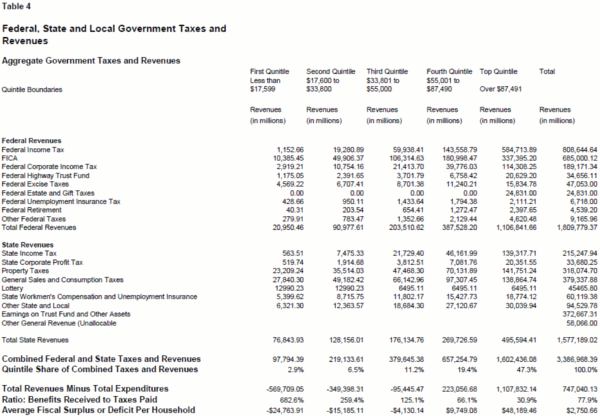
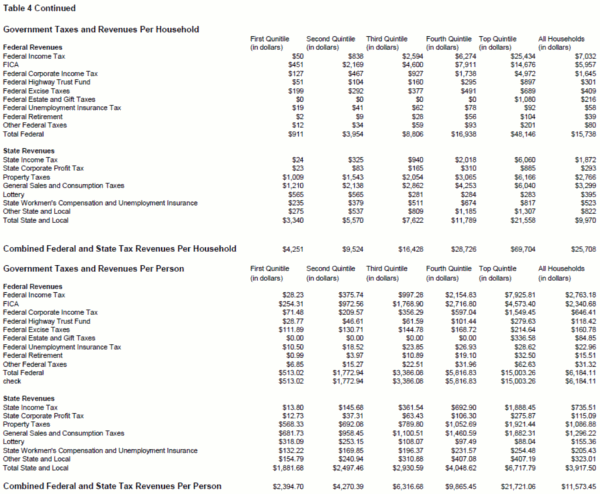
The findings (presented in detail in tables 3 and 4) are in agreement with previous research on fiscal distribution. The allocation of present government goods and services (including direct benefits, means-tested benefits, education services, and general population-based services) among the income quintiles was found to be relatively even, although slightly greater at lower incomes than at higher. For example, in 2004, the bottom quintile was found to receive 25.3 percent of present benefits and services at a cost of $667 billion. The top quintile was found to receive18.7 percent of government benefits and services at a cost of $494 billion.
The apparent evenness of the distribution of benefits and services between the household quintiles is, however, to a considerable degree an artifact driven by differences in the number of persons residing in each quintile. In particular the top income quintile of households has nearly 80 percent more persons than the bottom income quintile. When benefits and services received are converted to a per person basis, the apparent evenness in distribution disappears. The bottom quintile of households was found have substantially higher receipt of benefits (at $16,345 per person) than top income quintile (at $6,704 per person).
In contrast to distribution of benefits, the distribution of total taxes and revenues was found to be highly unequal. Overall the distribution in taxes and revenues was found to be roughly proportional to the distribution of income. As table 4 shows, the bottom income quintile paid 2.9 percent of all taxes and revenues while the top income quintile paid 47.3 percent. Tax and revenue payments from the top quintile amounted to $1.6 trillion. This sum was more than sixteen times greater than the $97 billion in payments made by the bottom quintile.
The rough equality in benefits and services received combined with the asymmetry in taxes paid generates a substantial redistribution of economic resources from higher to lower income households. The aggregate fiscal deficits or surpluses of each quintile are shown in Figure 2. The lowest income quintile received $569 billion more in benefits and services than it paid in taxes. By contrast, the top quintile paid $1.1 trillion more in taxes than it received in benefits and services.
Overall, as Figures 1 and 2 show, there was a transfer of roughly $1 trillion in economic resources from the top two quintiles to the bottom three. The lowest three quintiles received some $1.7 trillion in benefits and services while paying only around $700 billion in taxes. The resource gap of one trillion dollars was financed by higher income groups or by deficit financing.
The fourth and fifth income quintiles received some $928 billion in government benefits and services while paying $2.25 billion in taxes, thereby generating a fiscal surplus of around $1.3 trillion. This surplus was used to fund benefits for lower income households, pay debt obligations and fund public goods expenditures.
Figures 3 and 4 show the benefits and services received and taxes and revenues paid by the average household within each quintile. In the bottom quintile, the average household received $29,015 in benefits and paid $4,251 in taxes, generating an average fiscal deficit of $24,764 per household. In the top quintile, the average household paid $69,704 in taxes and received $21,515 in benefits and services, yielding an average fiscal surplus of $48,189 per household.
Figure 5 shows the benefits and services received and taxes paid per person within each quintile. The average individual in the bottom quintile received government benefits and services costing $16,345 in 2004 while paying $2,345 in taxes and revenues to the government. By contrast the average individual in the top income quintile, received $6,704 in government benefits and services while paying $21,721 in taxes in revenues.
Figure 6 expresses the benefits to tax balance within each quintile as a ratio of benefits and services received per $1.00 in taxes paid. The bottom quintile of households received $6.82 in benefits and services for each $1.00 in taxes paid. The second quintile received $2.59 in benefits and services for each $1.00 in taxes paid. By contrast the top quintile received 31 cents in benefits and services for every $1.00 in taxes paid.






Discussion
The overall transfer of a trillion dollars between quintiles is similar to that estimate of Chamberlain and Prante although details differ between the studies. One suspects that the estimated net transfer of a trillion dollars between income classes is somewhat larger than the sum imagined by liberals and smaller than that imagined by conservatives.
The current analysis suggests certain caveats and directions for future research. First, the ranking of households into quintiles based on money income is not a true pre-transfer ranking since money income includes Social Security and other government cash benefits. An analysis which employed pre-transfer definition of income for the initial ranking of households might show a greater magnitude of redistribution from the top to the bottom.
Second, a portion of the redistribution reflected in these numbers represents transfers from working age adults to retired adults. Redistribution between individuals over a lifetime may be less than redistribution over a single year.
Third, sensitivity analysis should be employed to test the role of various assumptions on the estimation results, (although the Chamberlain and Plante study showed stable results across a range of assumptions).
Fourth, micro-level analysis at the household rather than the quintile level would provide superior results but would be far more complex to perform.
Conclusion
A major function of modern government is the redistribution of economic resources. Economic redistribution can occur as a result of the direct transfer of benefits as well as the provision of services funded by other taxpayers. The present analysis suggests that one trillion dollars in resources is transferred from the two highest income household quintiles to the rest of the population. Roughly speaking, this sum would represent about 15 percent of income the higher income households. Further, public good expenditures (such as national defense and scientific research) and interest payments on the debt are financed solely by the two highest income quintiles. Lower income households benefit from these expenditures but do pay sufficient taxes to support them.
Appendix
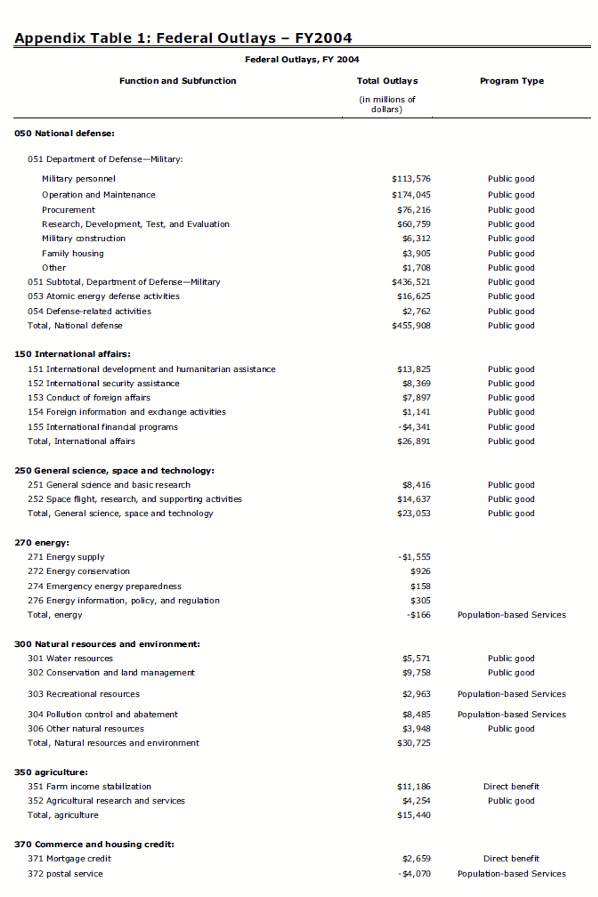
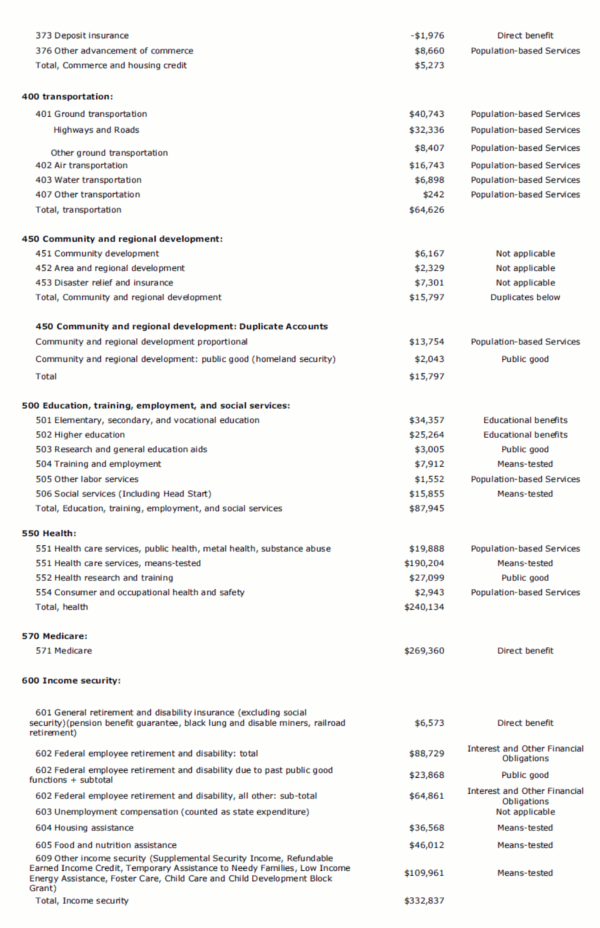
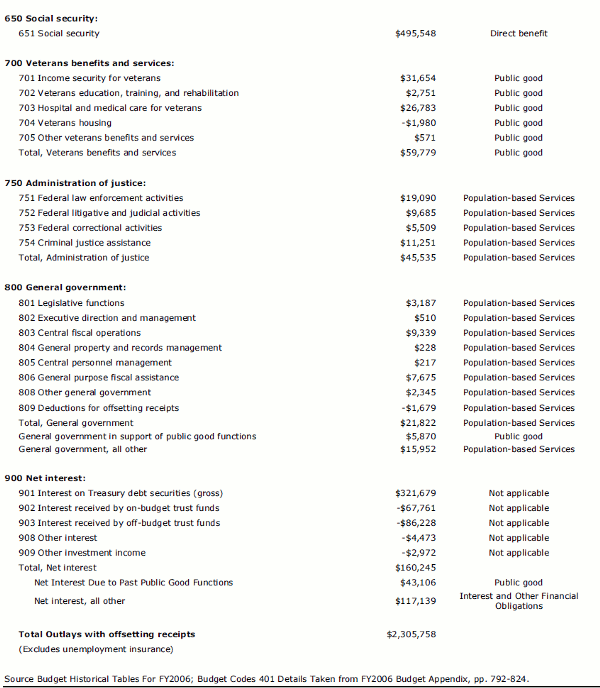
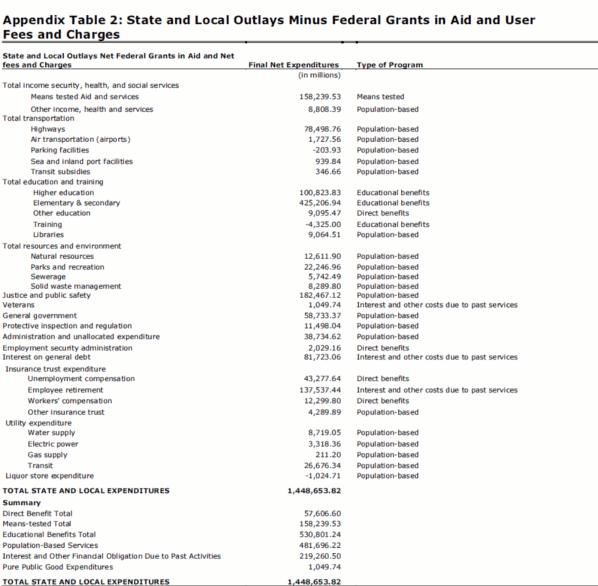
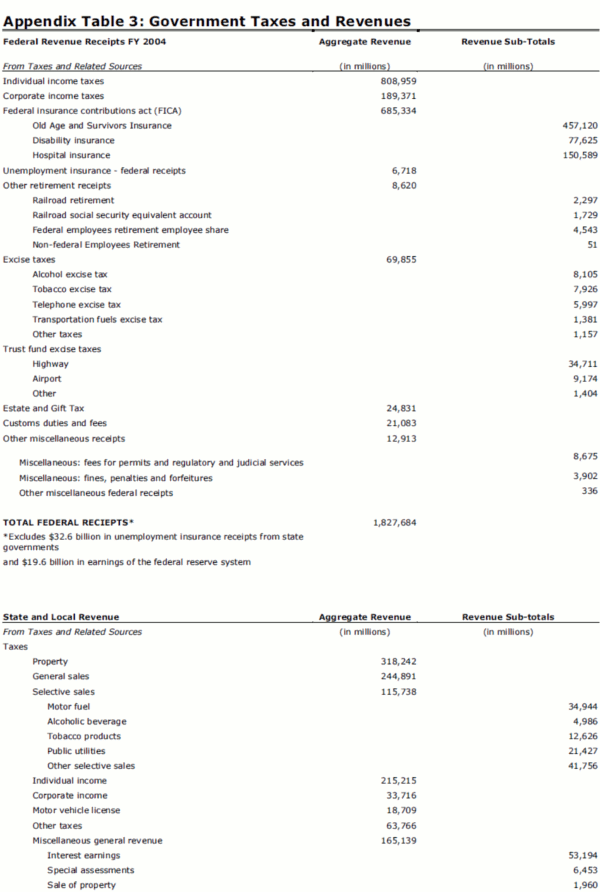
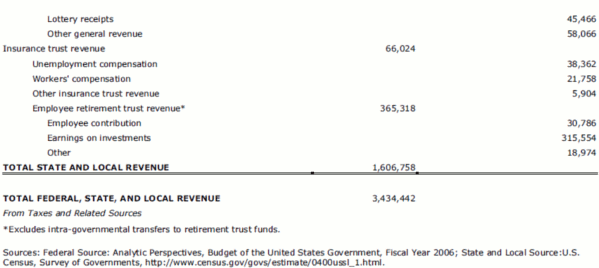
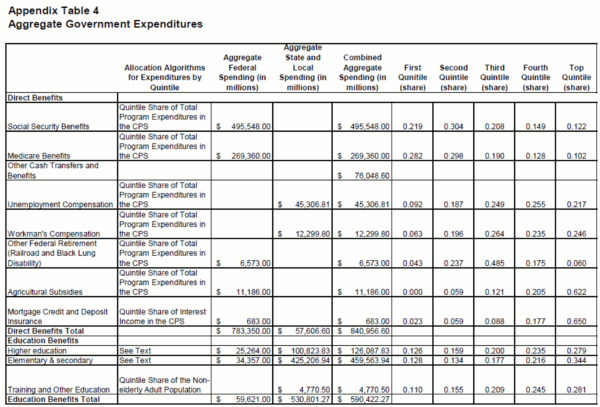
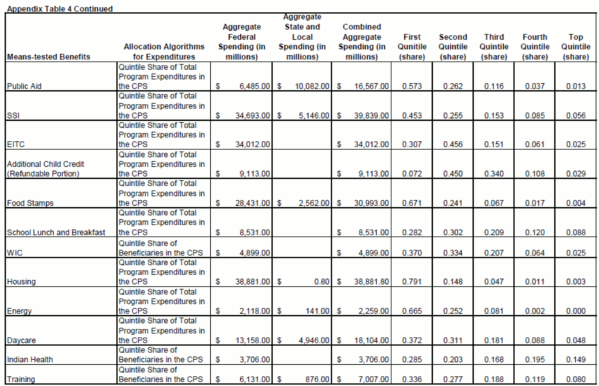
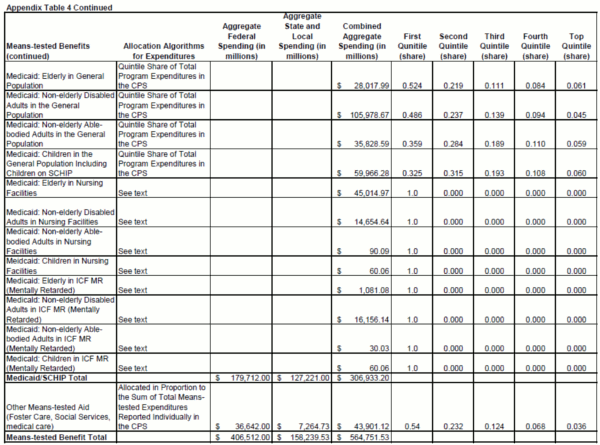
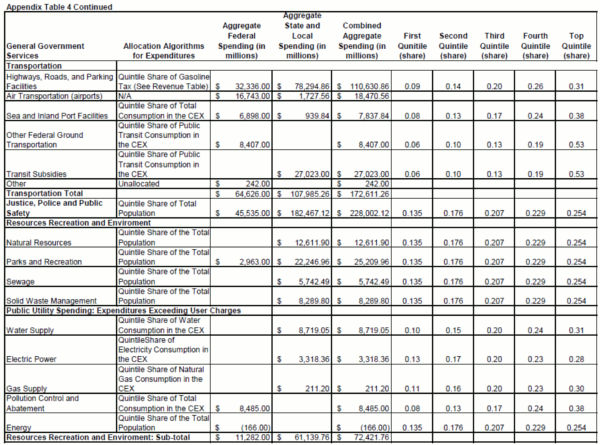
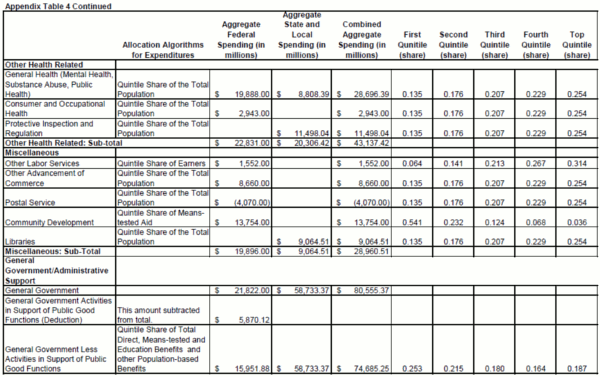
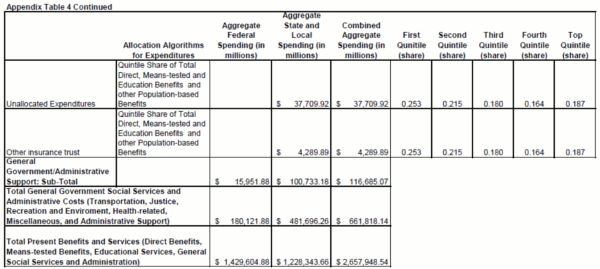
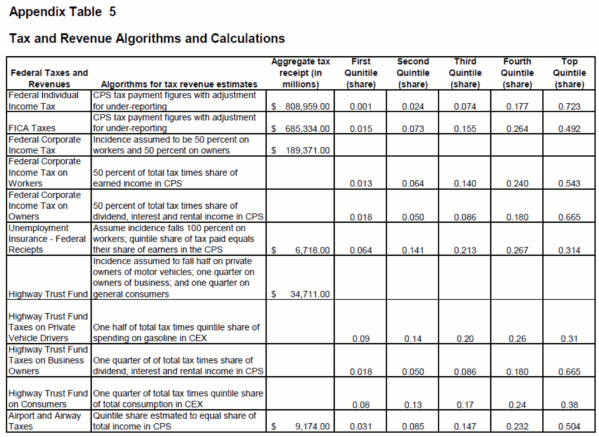
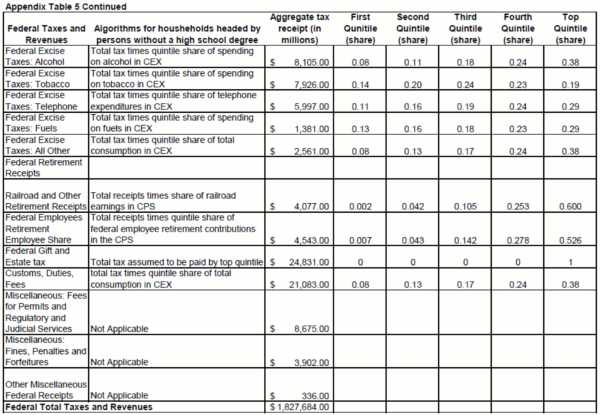
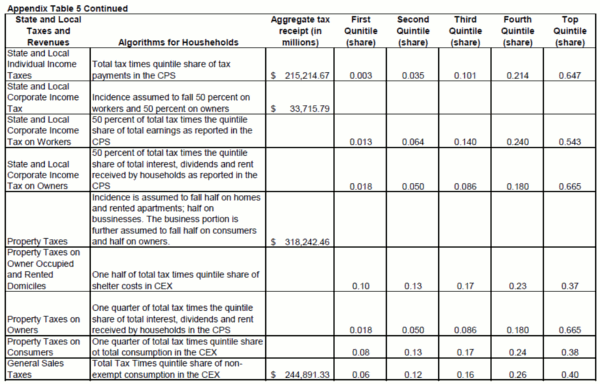
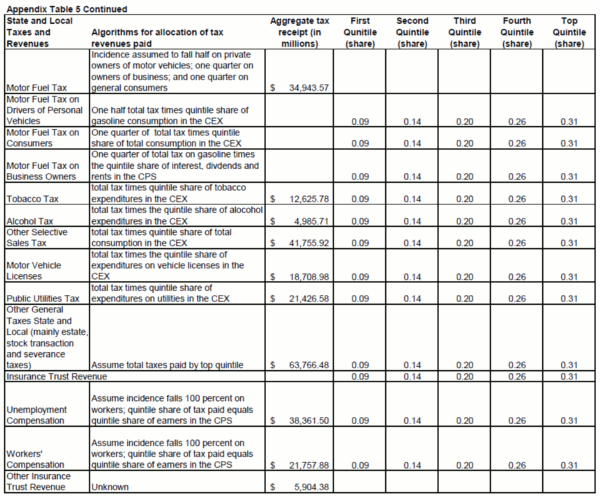
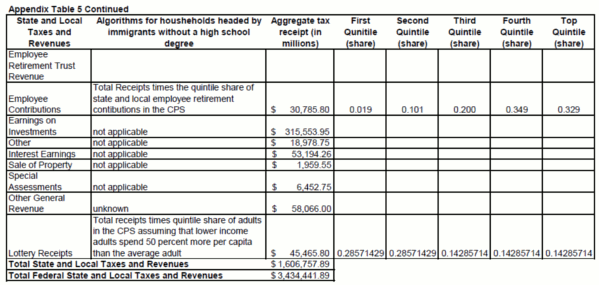
References
Aaron, Henry, & McGuire, Martin. (1970). Public Goods and Income Distribution. Econometrica, 38(6), 907-920.
Bianchi, Suzanne. (1995). The Changing Demographic and Socioeconomic Characteristics of Single Parent Families. Journal of Marriage and Family, 20, 71-95.
Bird, Richard. (1980). Income Redistribution Through the Fiscal System: The Limits of Knowledge. The American Economic Review, 70(2), pp. 77-81.
Bishop, George. (1967). Tax Burdens and Benefits of Government Expenditures By Income Class, 1961 and 1965. Washington, DC: Tax Foundation.
Brenna, Geoffrey. The Distributional Impact of Public Goods. Econometrica, 44(2), 391-399.
Buchanan, James M. (1968). The Demand and Supply of Public Goods. Liberty Fund, Library of Economics and Liberty. Available October 20, 2007, from http://ecsocman.edu.ru/db/msg/22866.html.
Chamberlain, Andrew, & Prante, Gerald. (2007). Who Pays Taxes and Who Receives Government Spending? An Analysis of Federal, State, and Local Tax and Spending Distributions, 1991-2004. Tax Foundation Working Paper No.1.
Congressional Research Service. (2006). Cash and Non-Cash Benefits for Persons with Limited Income: Eligibility Rules, Recipient and Expenditure Data, FY2002-2004.
Conrad, Alfred H. (1954) Redistribution Through Government Budgets in the United States, 1950. In Alan Peacock (Ed.), Income Redistribution and Social Policy: A set of Studies. Westport, CT: Greenwood Press Publishers.
Crane, Steven E. (1983). Interpreting the Distribution of Government Expenditures in Budget Incidence Studies. National Tax Journal, 36(2), 243 – 246.
Cronin, Julie-Anne. (1999). U.S. Treasury Distributional Analysis Methodology. U.S. Department of the Treasury, OTA Paper 85.
Demery, Lionel. (2000). Benefit Incidence: A Practitioner’s Guide. The World Bank.
Devarajan, Shantayana, & Hossain, Shaikh L. (1995). The Combined Incidence of Taxes and Public Expenditures in the Philippines. Policy Research Working Paper No. 1543. The World Bank.
Dyck, Dagmar. (2003). Fiscal Redistribution in Canada, 1994-2000. Department of Finance, Working Paper.
Gale, William G., & Slemrod, Joel. (2001). Rethinking the Estate and Gift Tax: Overview, NBER Working Paper No. 8205.
Garvey, D., & Espenshade, T. (1996). Fiscal Impact of New Jersey’s Immigrant and Native Households on State and Local Government: A New Approach and New Estimates. Office of Population Research, Princeton University.
Gillespie, Irwin. (1965). Effect of Public Expenditures on the Distribution of Income. In Richard A. Musgrave (Ed.), Essays in Fiscal Federalism (122-186). Washington, DC: Brookings Institution.
Goldman, Kalman, Pilgrim, John, & Flanagan, Edward. (1974). Local Government Fiscal Incidence by Socioeconomic Class and Type of Public Service. Nebraska Journal of Economics and Business, 13, 9-29.
Greene, Kenneth V., Neenan, William G., & Scott, Claudia D. (1976). Fiscal Incidence in the Washington Metropolitan Area. Land Economics, 52(1), 13-31.
Hammes, David L., & Wills, Douglas T. (1987). Public Debt, Interest and Fiscal Incidence. Review of Income and Wealth, 33(4), 439-442.
Harding, Ann, Lloyd, Rachel, & Warren, Neil. (2004). The Distribution of Taxes and Government Benefits in Australia. Paper presented at the Conference on the Distributional Effects of Government Spending and Taxation, The Levy Economics Institute.
Kaplow, Louis. (2006). Public Goods and the Distribution of Income. European Economic Review, 50, 1627-1660.
Lanjouw, Peter, & Ravallion, Martin. (1999). Benefit Incidence, Public Spending Reforms, and the Timing of Program Capture. The World Bank, 13(2), 257-273.
MaCurdy, Thomas, Nechyba, Thomas, & Bhattacharya, Jay. (1998). An Economic Framework for Assessing the Fiscal Impacts of Immigration. In James P. Smith and Barry Edmonston, (Eds.), The Immigration Debate: Studies on the Economic, Demographic and Fiscal Effects of Immigration. Washington, DC: National Academy Press.
Maital, Shlomo. (1973). Public Goods and Income Distribution: Some Further Results. Econometrica, 41(3), 561-568.
Martinez-Vazquez, Jorge. (1982). Fiscal Incidence at the Local Level. Econometrica, 50(5), 1207-1218.
Menchik, Paul. (1991). The Distribution of Federal Expenditure. National Tax Journal, 44(3), 269-276.
Office of Management and the Budget (OMB). (2006a). Analytical Perspective, Budget of the United States Government, Fiscal Year 2006.
Office of Management and the Budget (OMB). (2006b). Historical Tables, Budget of the United States Government, Fiscal Year 2006.
Randolph, William C. (2006). “International Burdens of the Corporate Income Tax,” Congressional Budget Office Working Paper No. 2006-09.
Rector, Robert & Kim, Christine, (2007). The Fiscal Cost of Low-Skill Immigrants to the U.S. Taxpayer, The Heritage Foundation Special Report, SR-14, May 2007
Reynolds, Morgan, & Smolensky, Eugene. (1977). Public Expenditures, Taxes and the Distribution of Income. New York, NY: Academic Press.
Ruggles, Patricia, & O’Higgins, Michael. (1981). The Distribution of Public Expenditure Among Households in the United States. Review of Income & Wealth, 27(2), 137-164.
Samuelson, Paul A. (1954). The Pure Theory of Public Expenditure. The Review of Economics and Statistics, 36(4), 387-389.
Schwartz, Gerd, Ter-Minassian. (2000). The Distributional Effect of Public Expenditure. Journal of Economic Surveys, 14(3), 337-357.
Smeeding, Timothy et al. (1993). Poverty, Inequality, and Family Living Standards Impacts Across Seven Nations: The Effect of Noncash Subsidies for Health, Education and Housing. Review of Income and Wealth, 39(3), 229-256.
Smith, James P., & Edmonston, Barry (eds.). (1997). The New Americans: Economic, Demographic, and Fiscal Effects of Immigration. Washington, D.C.: National Academy Press.
Sommers. Anna et al. (2006). Medicaid’s Long-Term Care Beneficiaries: An Analysis of Spending Patterns. Kaiser Commission on Medicaid and the Uninsured.
Tax Foundation. (1981). “Allocation Tax Burdens and Government Benefits By Income Class, 1972-73 and 1977,” Government Finance Brief No. 31. Washington, DCL: Tax Foundation.
U.S. Census Bureau. Current Population Survey (CPS) – Definitions and Explanations. Available October 17, 2007, from http://www.census.gov/population/www/cps/cpsdef.html.
U.S. Census Bureau, Survey of Government. October 19, 2007, from http://www.census.gov/govs/www/estimate.html.
U.S. Census Bureau. (2000). Federal, State and Local Governments: 1992 Government Finance and Employment Classification Manual. October 17, 2007, from http://www.census.gov/govs/www/class.html.
U.S. Census Bureau. (2006) Government Division, Public Education Finances, 2004. October 17, 2007, from http://www.census.gov/govs/www/school.html.
U.S. Department of Health and Human Services, Centers for Medicare and Medicaid Services. (2006). Medicare & Medicaid Statistical Supplement. October 17, 2007, from http://www.cms.hhs.gov/MedicareMedicaidStatSupp/.
van de Walle, Dominique. (1996). Assessing the Welfare Impacts of Public Spending. Policy Research Working Paper 1670. Washington, DC: The World Bank.
Wolff, Edward N., & Zacharias, Ajit. (2004). “An Overall Assessment of the Distributional Consequences of Government Spending and Taxation in the U.S., 1989 and 2000,” Paper presented at the Levy Economics Institute Conference.

